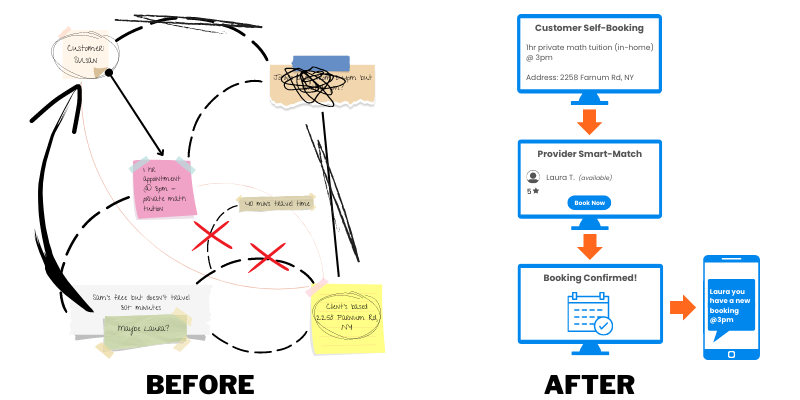Mobile Workforce Scheduling Best Practices: How to Schedule Mobile Workers
Discover the mobile workforce scheduling best practices to follow and increase efficiency in your scheduling process.
.png)
Scheduling employees can be tricky enough as it is. Throw multiple locations into the mix, and the challenge of scheduling mobile workers becomes harder than a New York Times Cryptic Crossword.
Mobile workforces enable businesses to service clients in their homes or chosen locations, offering the convenience and flexibility that the modern consumer craves. But as beneficial as this is for your sales figures, it adds an extra challenge to the poor soul in charge of scheduling. Since you’re reading this article, I’m guessing that’s you. (My sympathies!)
Luckily, mobile workforce scheduling doesn’t have to be complicated. With the right tools and processes, you can streamline scheduling and cut a complicated all-day task down to just a few minutes. It all comes down to the efficacy of your mobile workforce management.
What is Mobile Workforce Management?
Mobile workforce management is the catch-all term used to describe the tools and processes used to support, empower, and —you guessed it— manage mobile workers. What it looks like will be different from business to business, but universally, the goal is to improve your mobile employees' productivity, engagement, and satisfaction.
As you can imagine, efficient scheduling plays an important role in effective workforce management. So let’s dive into the best practices and steps you can take to improve your mobile workforce scheduling.
How to Schedule a Mobile Workforce?
#1. Define clear parameters in your booking and scheduling process
An efficient scheduling process for mobile workers starts with your customer booking process. Whether you let customers book themselves online (you should, it’s their preferred way to book) or you handle it via phone or email, establishing clear rules and parameters is key.
Parameters to implement if you haven’t already include:
- A minimum booking notice — the time between when a customer can request a service, and the service starts.
- Cancellation periods — how close to an appointment start time can a customer cancel/change the appointment without incurring a fee?
- Standard appointment lengths — how much time do you need to allocate in a provider's schedule for each appointment type?
Tip: Be realistic with your appointment times but build in a small window for unforeseen circumstances to avoid providers being perpetually late for the next booking.
For in-home service businesses, travel time is another critical factor. This is harder to predict depending on whether a provider travels from a fixed location for every appointment or moves from one job to another. Scheduling software like MarketBox enables providers to establish travel zones and assign each zone a unique schedule. By grouping bookings by area, you can maximize your booking calendar and avoid lengthy travel times disrupting your schedules.
#2. Empower employees to control their own schedules

If you’re struggling with mobile workforce scheduling, stop trying to schedule your mobile workforce! Instead, empower your employees to manage their own schedules.
If your service providers don’t work a set 9-5, some scheduling tools allow your workforce to establish their availability and pick up shifts and jobs on the go. As administrators, you still have ultimate control, but giving providers autonomy over their schedules can boost productivity, reduce employee turnover, and lead to a higher job acceptance rate.
As a bonus, fielding time-off requests is much easier, and with the ability to control response times, you can ensure your customers aren’t kept waiting.
#3. Communicate schedules, updates, and changes as early as possible
Another critical aspect of effective mobile workforce management is communication. When employees are rarely in the office — or don’t come in at all — maintaining effective communication channels can be more challenging.
Share employee schedules with as much notice as possible so employees can plan their workdays (and life) ahead of time. And for employees who are on the road a lot, schedules that are accessible via mobile devices are essential.
With a workforce scheduling tool that integrates with your online booking system, providers can be notified whenever a new booking occurs, or changes happen to bookings already in their schedule.
#4. Automate your scheduling for a faster and more efficient scheduling process

77% of in-home service businesses don't have an efficient scheduling process. As a result, they experience lengthy delays between customer inquiries and booking confirmations, inefficient schedules culminating in missed sales opportunities, and unnecessary back-and-forth between customers, admin, and providers.
As we’ve already established, scheduling employees who work across multiple locations isn’t easy. You can digitize the heavy lifting by implementing scheduling software into your mobile workforce management toolkit.
Most traditional scheduling software isn’t built to handle the complexity of mobile workforce scheduling. MarketBox, however, has been built specifically for service businesses with mobile and virtual workers. The software enables providers to establish travel zones (working radiuses) and smart-matches customers with providers in their area. When customers enter their address to book a service, they’ll only ever see providers who can travel to that location.
With the right software, matching customers with the right provider in the right location and at the right time happens instantly with zero effort.
#5. Track hours efficiently for easier payroll
When teams aren’t working set hours, scheduling isn’t the only thing that gets more complicated; payroll can be a complete nightmare! Due to the nature of the business, most service providers work hourly and won’t necessarily work the same number of hours week to week. Finding an effective way to track hours, including travel time, is essential to ensure employees are appropriately compensated and you don’t fall victim to time theft.
If your employees don’t start their day from the office, giving them a way to remotely clock in and out of work is necessary for recording when they’re working. Many mobile workforce management tools have a time-tracking feature. But don’t just count on it being included; you’d be surprised how many scheduling software forgets about this critical feature.
#6. Equip mobile workers with the tools they need to work efficiently
If your employees operate on the go, all the information they need to complete a job must be available remotely. Customer information like job locations, service preferences, and waivers need to be accessible via mobile devices. Few mobile service technicians want to lug a laptop around if they don’t need to!
While you might have already taken payment for a service at the time of booking, giving providers the ability to take payments or process additional charges will ensure you’re not missing out on upselling opportunities or being underpaid for the actual services that were provided.
#7. Make Job Requirements Clear During Recruitment
If you know last-minute call-outs are a key part of your business, or you expect mobile service providers to work regular overtime, make this clear during the hiring process. That way, when it comes to creating schedules, you’ll know you have a reliable workforce prepared to take on any job.
If you’re interested in learning how software can improve your scheduling process for mobile workers, book an introductory call with the team to chat with an expert.
Ready to transform your scheduling?
Talk to our sales team and see how MarketBox can help you achieve more with less effort




.svg)

